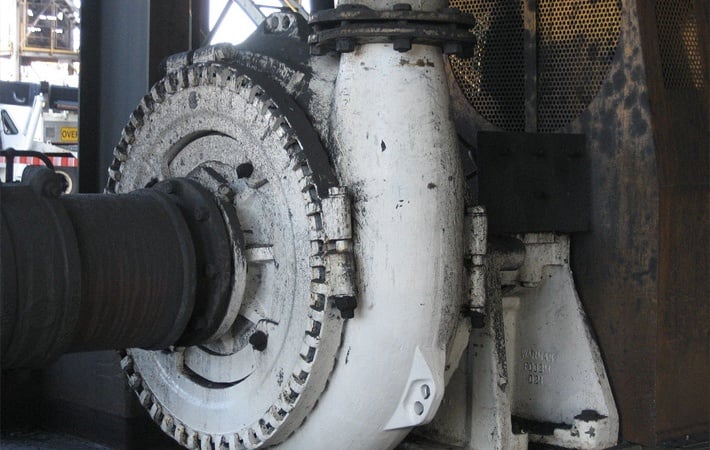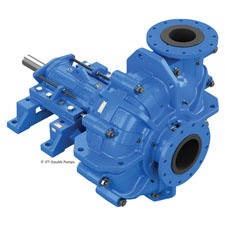

Understanding centrifugal pump curves is important for optimizing system performance, reducing energy consumption, and minimizing maintenance costs. While fully understanding a pump curve can be overwhelming, understanding the key components such as flow rate, head, efficiency, NPSH, and power consumption, is important to help organizations make informed decisions about pump selection, system design, and operation.
Different types of pumps (centrifugal, positive displacement, air-operated diaphragm, etc.) have different types of curves. In this post, Crane Engineering industrial pump experts will break down the anatomy of a centrifugal pump curve. Crane Engineering is the top distributor and servicer of industrial pumps in Wisconsin, Minnesota, and Michigan. Consult with an industrial pump expert to ensure your centrifugal pumps are operating at peak efficiency.
Here are some topics we will cover:
A centrifugal pump imparts energy on a liquid, and based on the system, has flow and head characteristics. The amount of required pressure the pump must overcome dictates where the performance point will be on the curve and how much flow is produced. As pressure increases, the flow decreases moving your performance point to the left of the curve. As pressure decreases, the performance point runs out to the right of the curve and flow increases.
When looking at curves for a new application, there are many factors to consider. But in most cases, a selection should be made as close to the Best Efficiency Point, or BEP, as possible. The BEP is an operating point along the performance curve that shows the highest efficiency point for the impeller diameter of the pump.
Ideally, pumps run at this point for their entire lives. But in real-world applications, system upsets and fluctuating demand cause pumps to operate outside ideal conditions. Here are some common terms you might hear when describing a pump running off its best efficiency point:
Why does it matter? Running a pump off its best efficiency point, one way or another can add, energy costs, but the biggest consequence of running off the BEP is an increased chance for failure.
Operating the pump to the left or right of BEP means the door is open to challenges like:
Now that we understand how a centrifugal pump operates and how to maintain efficiency, let’s review the basics of reading the curve.
Knowing how to read a centrifugal pump curve can help you correctly size a pump and troubleshoot any problems that arise. Let's go through some basic features of a pump curve. The title box is located at the top of the graph and provides information about the pump model, size, speed, and other identifying criteria specific to the pump. See the title box highlighted on the graph below.
When you take a look at the graph itself, you will see the flow rate (GPM) is on the x-axis of the pump curve.
The head is the vertical line on the y-axis. Usually, this is measured in feet.
The impeller trim (in) can be found at the beginning of the four horizontal curves, reading 9 in, 10 in, 11 in, 12 in, and 13 in.
Let's walk through an example of how to read the centrifugal pump curve. If the flow rate is 300 gallons per minute and there are 100 feet of head, we can see where the points intercept to determine the impeller diameter. In this example, our impeller diameter is roughly 10.5 inches. Now that we know our performance point, we can determine the amount of horsepower required. Horsepower is indicated across the curve as a dotted line, in this case at a downward angle. Our performance point is between the 10 and the 15 horsepower lines. We can estimate the selection will require 12 horsepower.
Last, but certainly not least, we need to figure out the minimum flow line. A centrifugal pump requires a minimum amount of flow moving through the pump to dissipate the heat created. On the left side of the curve, minimum flow is indicated by a bold vertical line. Operating to the left of this line is not recommended and can significantly decrease the life of the pump.
One common issue is determining the impeller trim when a nameplate has been lost or misplaced. To do this you will need a pressure gauge on the suction and discharge side of the pump. Close a valve on the discharge side of the pump and quickly measure the suction and discharge pressure. Reopen the discharge valve to return the pump to normal operating conditions. For this example, we will assume the suction pressure was 15 feet or 6.5 psi, and the discharge pressure was 165 feet and 71.5 psi. We can take the difference between the suction and the discharge pressure to get the dead head or no flow condition. Our result is 150 feet and 65 psi.
Looking at our pump curve we see that at 0 gallons per minute and 150 feet, we have a 12-inch diameter impeller. This test can also be used to determine if your pump is acting properly. If you know the diameter of your impeller and it's 13 inches you know that pump isn't performing to the capabilities. If we see the pump is not operating at the point it should be there is likely something wrong with the pump.
Engineers and experts rely on Crane Engineering for insight and support when it comes to centrifugal pumps and positive displacement pumps. Our team of experienced engineers are ready to answer your questions and provide expert guidance for industrial pumps, valves, and skid systems. As the top distributor and servicer of industrial pumps in Wisconsin, Minnesota, and Michigan, Crane Engineering can help you select the right pump for your application, fix pumps back to OEM standards, and build and design custom skid systems nationwide.
Let us know how we can help you, request a quote today!
These Stories on Pumps
Headquarters and Service Center
Located outside Green Bay, WI
707 Ford Street
Kimberly, WI 54136
920-733-4425
OptiFlow Design and Build Center
1002 Truman Street
Kimberly, WI 54136
920-733-4425
Burnsville Service Center
12265 Nicollet Avenue
Burnsville, MN 55337
952-444-1949
Grand Rapids Service Center
26489 Industrial Blvd
Cohasset, MN 55721
952-444-1949
© Copyright 2024. Crane Engineering. All Rights Reserved. Privacy Policy.